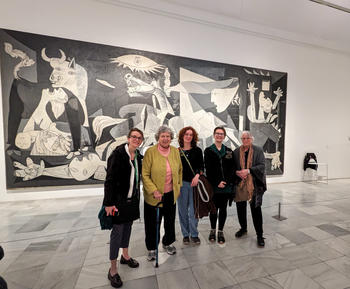
As spring breaks go, it was picture-perfect in every way.
UNC Pembroke art students Monika Czartoszewski and Jessica Plessinger spent their spring break soaking up art, history and culture during a memorable trip in March to visit some of the most important museums and cultural sites in Madrid, Spain. For Czartoszewski, a studio art major with a concentration in drawing and digital art, and Plessinger, an art major with a studio track concentration in painting, it was a journey they wouldn’t soon forget.
“It was great to see pieces I’ve learned about in class,” said Plessinger. “Seeing historical paintings from the old masters up close is fantastic.”
The pair traveled with UNCP art faculty members Carla Rokes and Beata Niedzialkowska, plus Vivian R. Jacobson, a UNCP donor, lecturer, author and art enthusiast who worked closely with the French-Russian artist Marc Chagall, and BreAnna Branch, assistant vice chancellor for Advancement.
The week featured two visits to Chagall—The Cry for Freedom, an exhibition of the artist’s work at the Fundación MAPFRE in Madrid that offered a fresh perspective on his work through the lens of historical events Chagall witnessed. Jacobson arranged a visit with the venue’s curator and director of education and a private tour of the exhibit.
“This was a wonderful opportunity for our students to learn the process behind the curation of the show,” Rokes said. “They learned about the political content of Chagall’s work and his connection to the political themes in his work.”
Czartoszewski embarked on the trip especially eager to learn more about Chagall, the 20th-century artist known for his distinct abstract style of dream-like figurative and narrative art that explored his Jewish identity and life in Russia. She had researched Chagall’s work for a class with Rokes, then created a drawing inspired by the artist’s style displayed at a Chagall lecture by Jacobson on campus in October 2023.
“Being immersed in Chagall’s art and other similar works was phenomenal,” said Czartoszewski. “There is such a difference between looking at an artist’s work on a screen and seeing in person the paint as it has been moved. It’s not flat; there is texture, there are lumps. It’s incredible to see.”
Making a connection with Jacobson, who donated her personal collection of books, letters, photos and other materials about Chagall to UNC Pembroke in 2021, was a highlight for Czartoszewski.
“It’s so rare to meet someone who worked directly with a famous artist like she did,” Czartoszewski said of Jacobson. “I learned so much from her about Chagall’s life and what influenced his work. She is a remarkable woman!”
Jacobson, who provided financial support for the students’ travel, was equally gratified to share her knowledge with Czartoszewski and Plessinger.
“It’s a wonderful opportunity for them to learn about Chagall’s work and to carry it forward,” Jacobson said. “Students like Monika and Jessica will continue to share Chagall’s messages of hope, peace, reconciliation and love with the world, which means a great deal to me.”
The UNCP group also visited the Reina Sofia, Spain’s national museum of 20th-century art. On display was a Pablo Picasso exhibition featuring “Guernica,” a 1937 oil painting considered one of the artist’s most famous works. Another day was spent at the Prado, Spain’s main national art museum, which holds much of the former Spanish royal art collection.
Plessinger said it was invaluable to see original pieces in person while having faculty like Niedzialkowska’s expertise to provide context.
“When you get up close with those works, you see the techniques the artist used, which are things you can’t see on a phone or computer screen,” Plessinger said. “And Beata could talk about the things happening during the period that influenced the artist’s work.”
Niedzialkowska said travel to different countries makes learning come to life for art students like Plessinger and Czartoszewski.
“It exposes students to other people and things they don’t experience in the classroom. Traveling and seeing other cultures is an invaluable experience, especially for art and art history students. Seeing new art and architecture in person is so important.”
Rounding out the week was a day trip to Toledo, located about an hour southwest of Madrid. The ancient walled city on a hill is known for its medieval Arab, Jewish and Christian monuments and is also the home of El Greco, a famous 17th-century painter.
Czartoszewski said the week in Spain has given her a renewed sense of confidence about what lies ahead after she graduates in December 2024.
“Because of this trip, I’ve come to realize I have a chance at getting a job in another country, especially in the art community,” she said. “Travel can be for fun, but it can also improve you as a person.”